Socioeconomic Impact Evaluation for Near Real-Time Flood Detection in the Lower Mekong River Basin
Abstract
:1. Introduction
2. Background and Motivation
2.1. Study Area
2.2. The 2011 Southeast Asia Floods
2.3. Flood Impact Assessments
3. Materials and Methods
3.1. Inundation Depth Estimation
3.2. Land Use/Land Cover Map
3.3. Infrastructure and Population Density
3.4. Damage Model
4. Results
4.1. Land Cover Damages
4.2. Infrastructure Damages
4.3. Populations Affected
5. Discussion and Conclusions
5.1. Flood Depth Estimates
5.2. Damage Estimate Validation
6. Future Work
Acknowledgments
Author Contributions
Conflicts of Interest
Appendix A
| Land Utility | Maximum Damage Value (Si) |
|---|---|
| Rice Rotated with Annual Crop | 0.078 |
| Annual Crop | 0.109 |
| Shifting Cultivation | 0.109 |
| Orchard | 0.03 |
| Flooded Forest | 0.84 |
| Grassland | 0.03 |
| Shrub Land | 0.03 |
| Urban | 29 |
| Bare Land | - |
| Industrial Plantation | 0.3 |
| Deciduous Forest | 0.84 |
| Evergreen Forest | 0.84 |
| Forest Plantation | 0.84 |
| Bamboo Forest | 0.147 |
| Coniferous Forest | 0.84 |
| Mangrove | 0.639 |
| Marsh/Swamp | 0.03 |
| Aquaculture | 1.706 |
| Aquaculture Rotated with Rice | 0.639 |
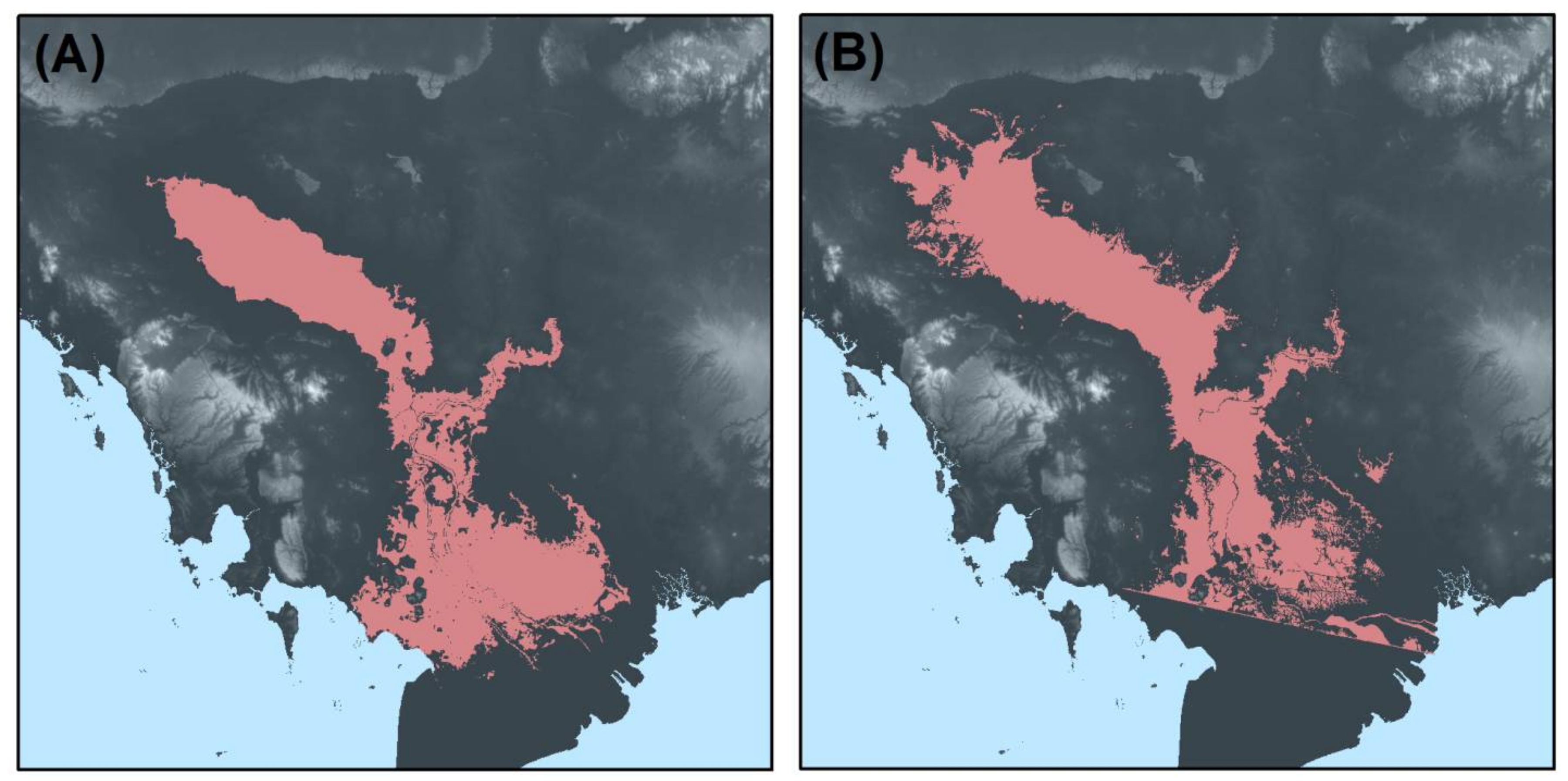
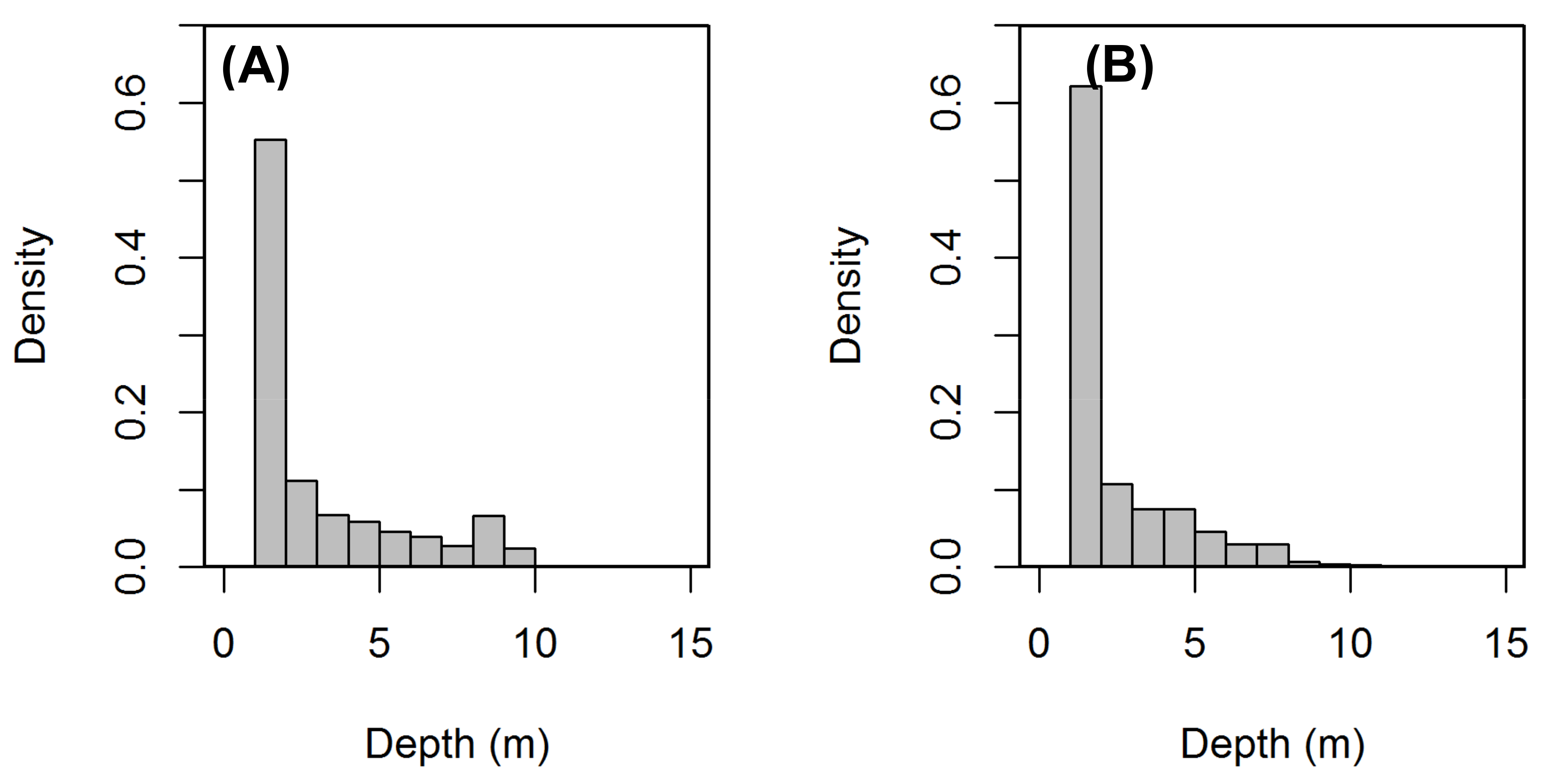
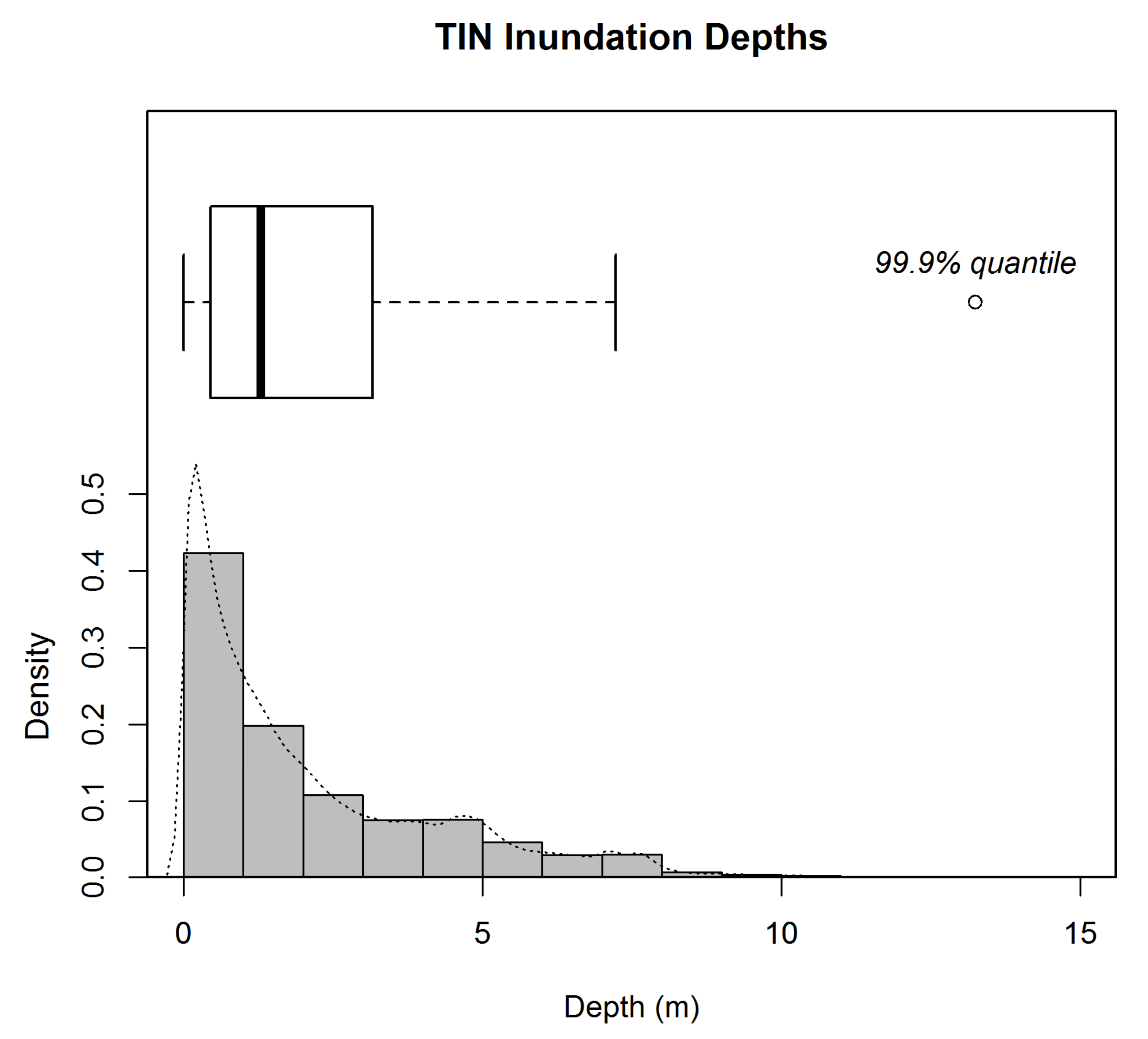
References
- Guha-Sapir, D.; Vos, F.; Below, R.; Ponserre, S. Annual Disaster Statistical Review 2011: The Numbers and Trends; Centre for Research on the Epidemiology of Disasters (CRED): Brussels, Belgium, 2012. [Google Scholar]
- Ahamed, A.; Bolten, J.D. A MODIS-based automated flood monitoring system for Southeast Asia. Int. J. Appl. Earth Obs. Geoinf. 2017, 61, 104–117. [Google Scholar] [CrossRef]
- Jongman, B.; Kreibich, H.; Apel, H.; Barredo, J.I.; Bates, P.D.; Feyen, L.; Gericke, A.; Neal, J.; Aerts, J.C.J.H.; Ward, P.J. Comparative flood damage model assessment: Towards a European approach. Nat. Hazards Earth Syst. Sci. 2012, 12, 3733–3752. [Google Scholar] [CrossRef] [Green Version]
- Mekong River Commission (MRC). State of the Basin Report 2010; Mekong River Commission: Vientiane, Laos, 2010. [Google Scholar]
- Pech, S.; Sunada, K. Population growth and natural-resources pressures in the Mekong River Basin. AMBIO J. Hum. Environ. 2008, 37, 219–224. [Google Scholar] [CrossRef]
- IPCC Managing the Risks of Extreme Events and Disasters to Advance Climate Change Adaptation. In A Special Report of Working Groups I and II of the Intergovernmental Panel on Climate Change; Field, C.B.; Barros, V.; Stocker, T.F.; Dahe, Q.; Dokken, D.J.; Ebie, K.L.; Mastrandrea, M.D.; Mach, K J.; Plattner, G.-K.; Allen, S.K.; et al. (Eds.) Cambridge University Press: Cambridge, UK, 2012; p. 582. ISBN 978-1-107-02506-6. [Google Scholar]
- Nicholls, R.J.; Hanson, S.; Herweijer, C.; Patmore, N.; Hallegatte, S.; Corfee-Morlot, J.; Château, J.; Muir-Wood, R. Ranking Port Cities with High Exposure and Vulnerability to Climate Extremes; Organisation for Economic Co-operation and Development: Paris, France, 2008. [Google Scholar]
- Perera, E.D.P.; Sayama, T.; Magome, J.; Hasegawa, A.; Iwami, Y. RCP8.5-Based Future Flood Hazard Analysis for the Lower Mekong River Basin. Hydrology 2017, 4, 55. [Google Scholar] [CrossRef]
- Fayne, J.V.; Bolten, J.D.; Doyle, C.S.; Fuhrmann, S.; Rice, M.T.; Houser, P.R.; Lakshmi, V. Flood mapping in the lower Mekong River Basin using daily MODIS observations. Int. J. Remote Sens. 2017, 38, 1737–1757. [Google Scholar] [CrossRef]
- Merz, B.; Kreibich, H.; Schwarze, R.; Thieken, A. Review article “Assessment of economic flood damage”. Nat. Hazards Earth Syst. Sci. Katlenburg-Lindau 2010, 10, 1697. [Google Scholar] [CrossRef]
- Oddo, P.C.; Lee, B.S.; Garner, G.G.; Srikrishnan, V.; Reed, P.M.; Forest, C.E.; Keller, K. Deep Uncertainties in Sea-Level Rise and Storm Surge Projections: Implications for Coastal Flood Risk Management. Risk Anal. 2017. [Google Scholar] [CrossRef] [PubMed]
- Gaume, E.; Borga, M. Post-flood field investigations in upland catchments after major flash floods: Proposal of a methodology and illustrations. J. Flood Risk Manag. 2008, 1, 175–189. [Google Scholar] [CrossRef]
- World Bank. Vietnam 2016: Rapid Flood Damage and Needs Assessment; The World Bank Group: Washington, DC, USA, 2016; Available online: https://www.gfdrr.org/sites/default/files/publication/Vietnam%20Rapid%20Damage_FinalWebv3.pdf (accessed on 4 April 2018).
- Kwak, Y.; Arifuzzanman, B.; Iwami, Y. Prompt Proxy Mapping of Flood Damaged Rice Fields Using MODIS-Derived Indices. Remote Sens. 2015, 7, 15969–15988. [Google Scholar] [CrossRef]
- Poser, K.; Dransch, D. Volunteered geographic information for disaster management with application to rapid flood damage estimation. Geomatica 2010, 64, 89–98. [Google Scholar]
- Leenders, J.K.; Wagemaker, J.; Roelevink, A.; Rientjes, T.H.M.; Parodi, G. Development of a damage and casualties tool for river floods in northern Thailand. In Flood Risk Management: Research and Practice; Taylor & Francis: London, UK, 2009; pp. 1707–1715. ISBN 978-0-415-48507-4. [Google Scholar]
- Giang, N.T.; Chen, J.; Phuong, T.A. A method to construct flood damage map with an application to Huong River basin, in Central Vietnam. J. Sci. Earth Environ. Sci. 2009, 25, 10–19. [Google Scholar]
- Wagemaker, J.; Leenders, J.; Huizinga, J. Economic valuation of flood damage for decision makers in the Netherlands and the Lower Mekong River Basin. In Proceedings of the 6th Annual Mekong Flood Forum, Phnom Penh, Cambodia, 27–28 May 2008; pp. 27–28. [Google Scholar]
- Mekong River Commission (MRC). Annual Mekong Flood Report 2011; Mekong River Commission: Vientiane, Laos, 2011; p. 72. [Google Scholar]
- Ahamed, A.; Bolten, J.; Doyle, C.; Fayne, J. Near Real-Time Flood Monitoring and Impact Assessment Systems. In Remote Sensing of Hydrological Extremes; Lakshmi, V., Ed.; Springer: Cham, Switzerland, 2017; pp. 105–118. ISBN 978-3-319-43743-9. [Google Scholar]
- Chinh, D.T.; Bubeck, P.; Dung, N.V.; Kreibich, H. The 2011 flood event in the Mekong Delta: Preparedness, response, damage and recovery of private households and small businesses. Disasters 2016, 40, 753–778. [Google Scholar] [CrossRef] [PubMed]
- Chinh, D.; Dung, N.; Gain, A.; Kreibich, H. Flood Loss Models and Risk Analysis for Private Households in Can Tho City, Vietnam. Water 2017, 9, 313. [Google Scholar] [CrossRef]
- Kamoshita, A.; Ouk, M. Field level damage of deepwater rice by the 2011 Southeast Asian Flood in a flood plain of Tonle Sap Lake, Northwest Cambodia. Paddy Water Environ. 2015, 13, 455–463. [Google Scholar] [CrossRef]
- Liu, S.; Lu, P.; Liu, D.; Jin, P.; Wang, W. Pinpointing the sources and measuring the lengths of the principal rivers of the world. Int. J. Digit. Earth 2009, 2, 80–87. [Google Scholar] [CrossRef]
- Mekong River Commission (MRC). Overview of the Hydrology of the Mekong Basin; Mekong River Commission: Vientiane, Laos, 2005. [Google Scholar]
- Kuenzer, C.; Guo, H.; Schlegel, I.; Tuan, V.Q.; Li, X.; Dech, S. Varying Scale and Capability of Envisat ASAR-WSM, TerraSAR-X Scansar and TerraSAR-X Stripmap Data to Assess Urban Flood Situations: A Case Study of the Mekong Delta in Can Tho Province. Remote Sens. 2013, 5, 5122–5142. [Google Scholar] [CrossRef] [Green Version]
- Tang, J.C.; Vongvisessomjai, S.; Sahasakmontri, K. Estimation of flood damage cost for Bangkok. Water Resour. Manag. 1992, 6, 47–56. [Google Scholar] [CrossRef]
- Dun, O. Migration and Displacement Triggered by Floods in the Mekong Delta. Int. Migr. 2011, 49, e200–e223. [Google Scholar] [CrossRef]
- Guha-Sapir, D.; Below, R.; Hoyois, P. EM-DAT: International Disaster Database; Catholic University of Louvain: Brussels, Belgium, 2015. [Google Scholar]
- Haraguchi, M.; Lall, U. Flood risks and impacts: A case study of Thailand’s floods in 2011 and research questions for supply chain decision making. Int. J. Disaster Risk Reduct. 2015, 14, 256–272. [Google Scholar] [CrossRef]
- Department of Disaster Prevention and Mitigation (DDPM). National Disaster Risk Management Plan; Department of Disaster Prevention and Mitigation, Ministry of Interior: Bankok, Thailand, 2015.
- Sluimer, G.; Ogink, H.; Diermanse, F.; Keukelaar, F.; Jonkman, B.; Thanh, T.K.; Sopharith, T. Best Practice Guidelines for Flood Risk Assessment in the Lower Mekong River Basin. In Proceedings of the 7th Annual Mekong Flood Forum, Bankok, Thailand, 13–14 May 2009; p. 284. [Google Scholar]
- Lekuthai, A.; Vongvisessomjai, S. Intangible flood damage quantification. Water Resour. Manag. 2001, 15, 343–362. [Google Scholar] [CrossRef]
- Jonkman, S.N. Global perspectives on loss of human life caused by floods. Nat. Hazards 2005, 34, 151–175. [Google Scholar] [CrossRef]
- Jonkman, S.N. Loss of Life Estimation in Flood Risk Assessment: Theory and Applications. Ph.D. Thesis, Delft University of Technology, Delft, The Netherlands, June 2007. [Google Scholar]
- Bessette, D.L.; Mayer, L.A.; Cwik, B.; Vezér, M.; Keller, K.; Lempert, R.J.; Tuana, N. Building a Values-Informed Mental Model for New Orleans Climate Risk Management. Risk Anal. 2017, 37, 1993–2004. [Google Scholar] [CrossRef] [PubMed]
- Federal Emergency Management Agency (FEMA). HAZUS: Multi-Hazard Loss Estimation Model Methodology—Flood Model; Federal Emergency Management Agency: Washington, DC, USA, 2003.
- Kok, M.; Huizinga, H.J.; Vrouwenfelder, A.; Barendregt, A. Standard Method 2004. Damage and Casualties Caused by Flooding; Rijkswaterstaat: Delft, The Netherlands, 2004. [Google Scholar]
- UN Operational Satellite Applications Programme (UNOSAT). Flood Analysis for Cambodia 2014; UNOSAT: Phnom Penh, Cambodia, 2014; Available online: http://floods.unosat.org/geoportal/catalog/search/resource/details.page?uuid=%7B85A44723-2428-4387-B509-70191C0F7B60%7D (accessed on 28 March 2018).
- UNOSAT Flood Vectors-ASARWSM (27 September 2011) 2014. Available online: http://floods.unosat.org/geoportal/FP01/FL20111012KHM.gdb.zip (accessed on 28 March 2018).
- Cham, T.C.; Mitani, Y.; Fujii, K.; Ikemi, H. Evaluation of flood volume and inundation depth by GIS midstream of Chao Phraya River Basin, Thailand. In WIT Transactions on the Built Environment; Brebbia, C.A., Ed.; WIT Press: Southampton, UK, 2016; Volume 2, pp. 1049–1960. ISBN 978-1-78466-157-1. [Google Scholar]
- Yamazaki, D.; Ikeshima, D.; Tawatari, R.; Yamaguchi, T.; O’Loughlin, F.; Neal, J.C.; Sampson, C.C.; Kanae, S.; Bates, P.D. A high-accuracy map of global terrain elevations. Geophys. Res. Lett. 2017, 44, 5844–5853. [Google Scholar] [CrossRef]
- Kityuttachai, K.; Heng, S.; Sou, V. Land Cover Map of the Lower Mekong Basin; Mekong River Commission: Phnom Penh, Cambodia, 2016; p. 82. [Google Scholar]
- Center for International Earth Science Information Network (CIESIN). Gridded Population of the World, Version 4 (GPWv4): Population Density 2016. Available online: http://dx.doi.org/10.7927/H4NP22DQ (accessed on 7 November 2017).
- CIESIN. ITOS Global Roads Open Access Data Set, Version 1 (gROADSv1) 2013. Available online: http://dx.doi.org/10.7927/H4VD6WCT (accessed on 7 November 2017).
- OpenStreetMap Contributors. OpenStreetMap. Available online: https://www.openstreetmap.org/ (accessed on 7 November 2017).
- Haklay, M.; Weber, P. Openstreetmap: User-generated street maps. IEEE Pervasive Comput. 2008, 7, 12–18. [Google Scholar] [CrossRef]
- Organisation for Economic Co-operation and Development (OECD). Definition of Functional Urban Areas (FUA) for the OECD Metropolitan Database; Organisation for Economic Co-operation and Development: Paris, France, 2013. [Google Scholar]
- Chen, J. Flood Damage Map for the Huong River Basin; University of Twente: Enschede, The Netherlands, 2007. [Google Scholar]
- Central Region Urban Environmental Improvement Project (CRUEIP). Supplementary Appendix [Resettlement plan]; Report and Recommendation of the President to the Board of Directors on a Proposed Loan to the Socialist Republic of Viet Nam for the Central Region Urban Environmental Improvement Project; Asian Development Bank: Manila, Philippines, 2003. [Google Scholar]
- Wang, W.; Lu, H.; Yang, D.; Sothea, K.; Jiao, Y.; Gao, B.; Peng, X.; Pang, Z.; Schumann, G.J.-P. Modelling Hydrologic Processes in the Mekong River Basin Using a Distributed Model Driven by Satellite Precipitation and Rain Gauge Observations. PLoS ONE 2016, 11, e0152229. [Google Scholar] [CrossRef] [PubMed]
- MRC. Mekong River Real Time Water Level Monitoring. Available online: http://monitoring.mrcmekong.org/ (accessed on 12 February 2018).
- Vinck, P. World Disasters Report: Focus on Technology and the Future of Humanitarian Action; International Federation of Red Cross and Red Crescent Societies: Geneva, Switzerland, 2013. [Google Scholar]
- Raza, S.F.; Ahsan, M.S.; Ahmad, S.R. Rapid assessment of a flood-affected population through a spatial data model. J. Flood Risk Manag. 2017, 10, 219–225. [Google Scholar] [CrossRef]
- Dutta, D.; Herath, S.; Musiake, K. A mathematical model for flood loss estimation. J. Hydrol. 2003, 277, 24–49. [Google Scholar] [CrossRef]
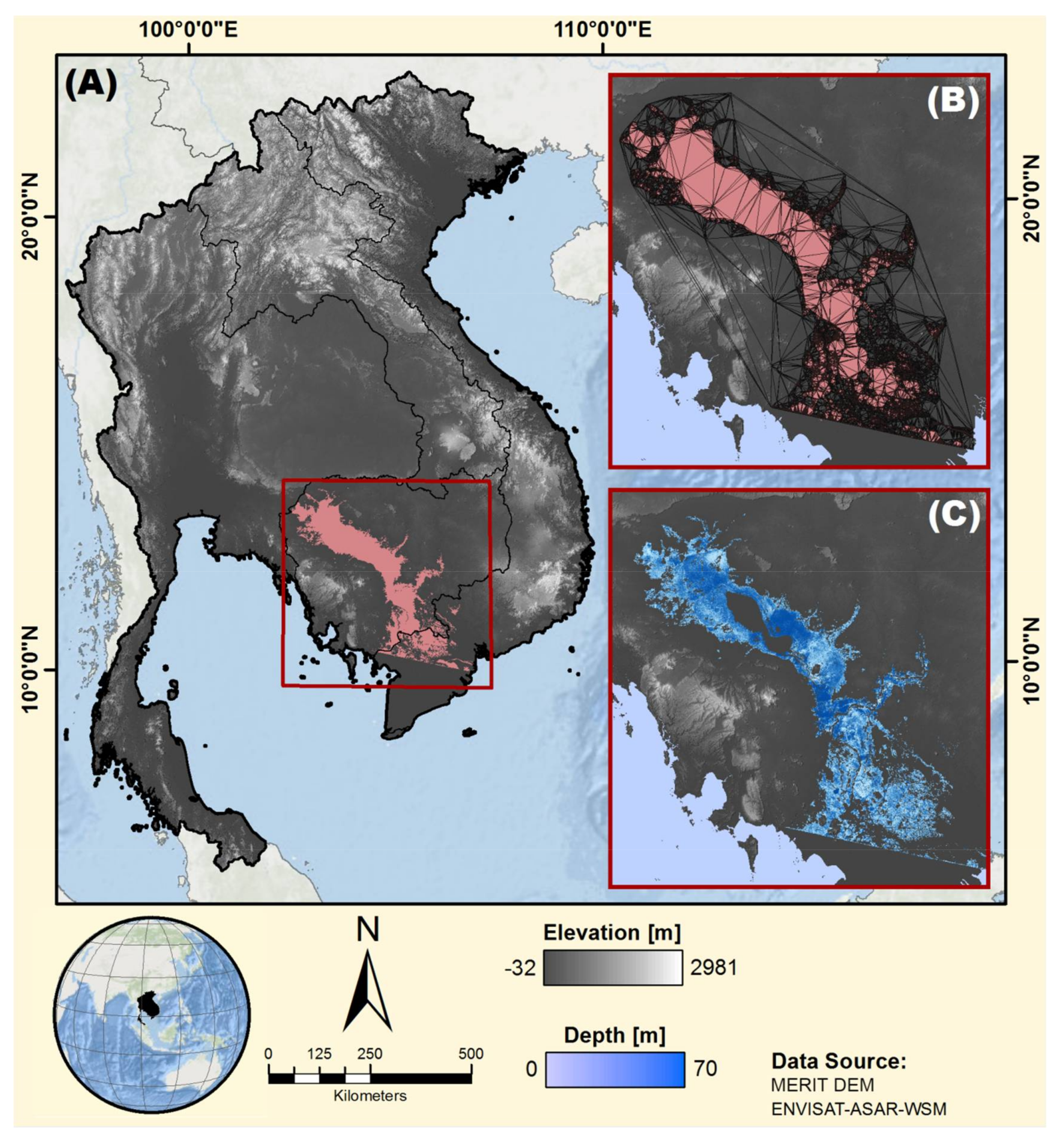
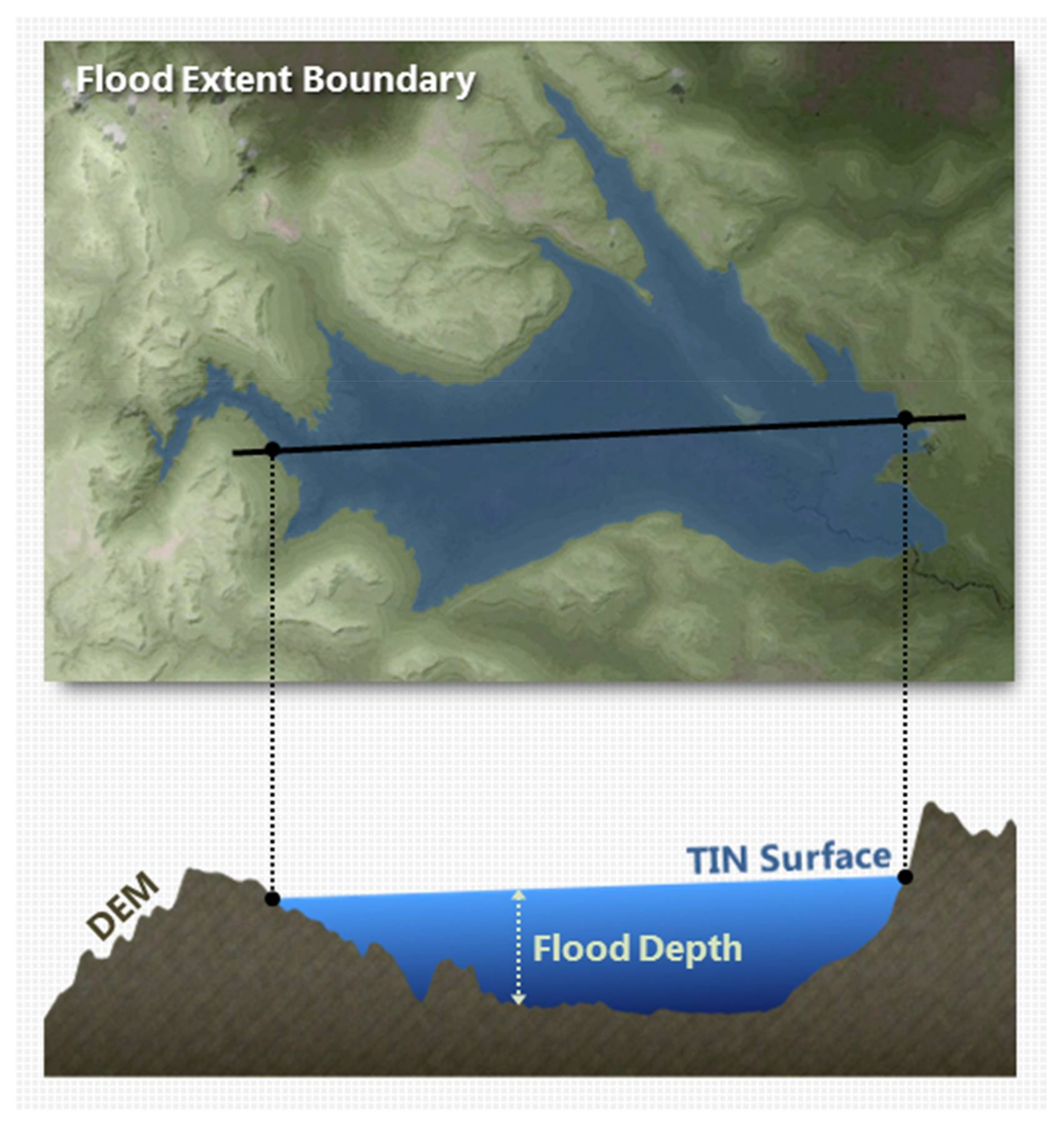
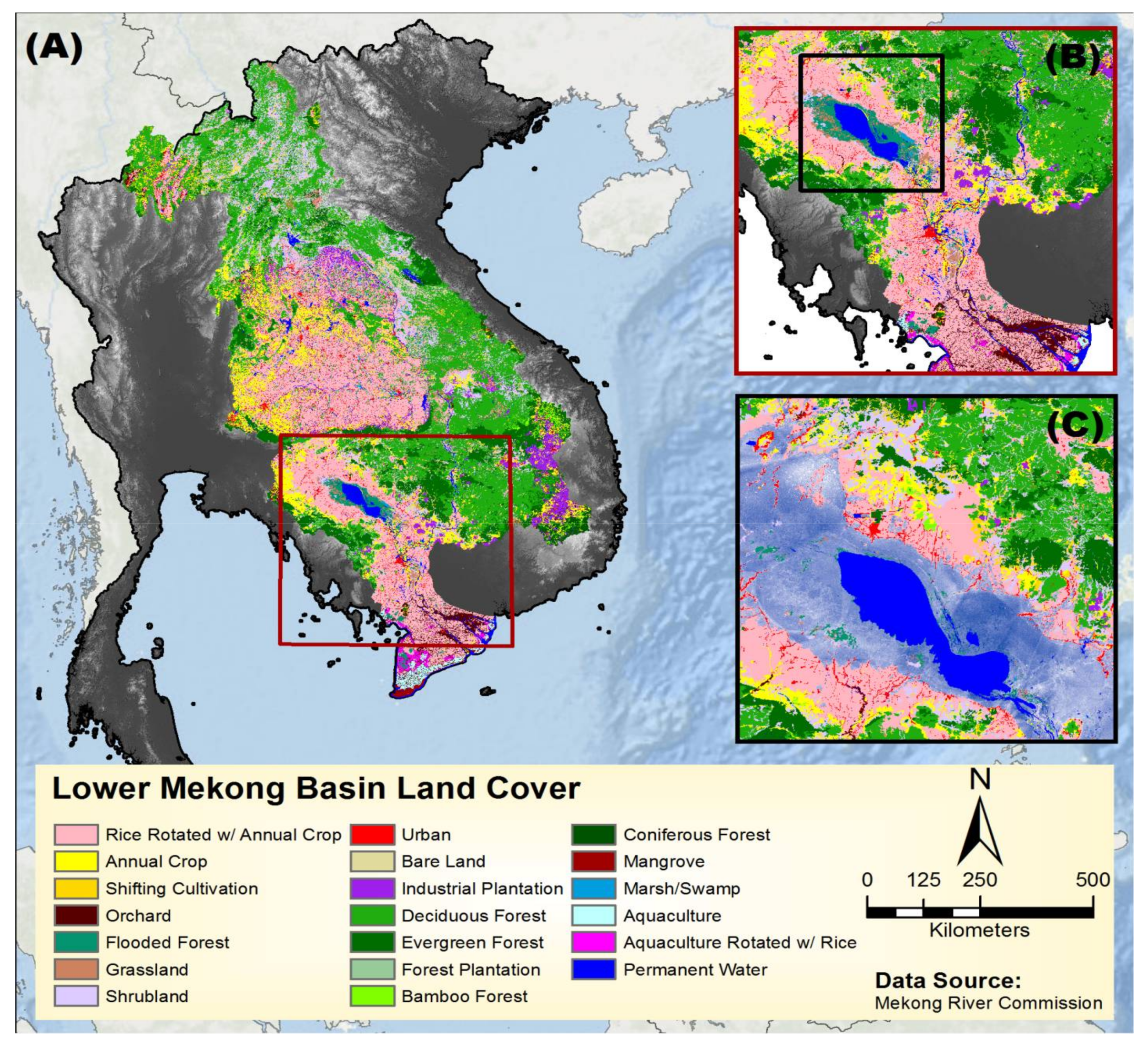
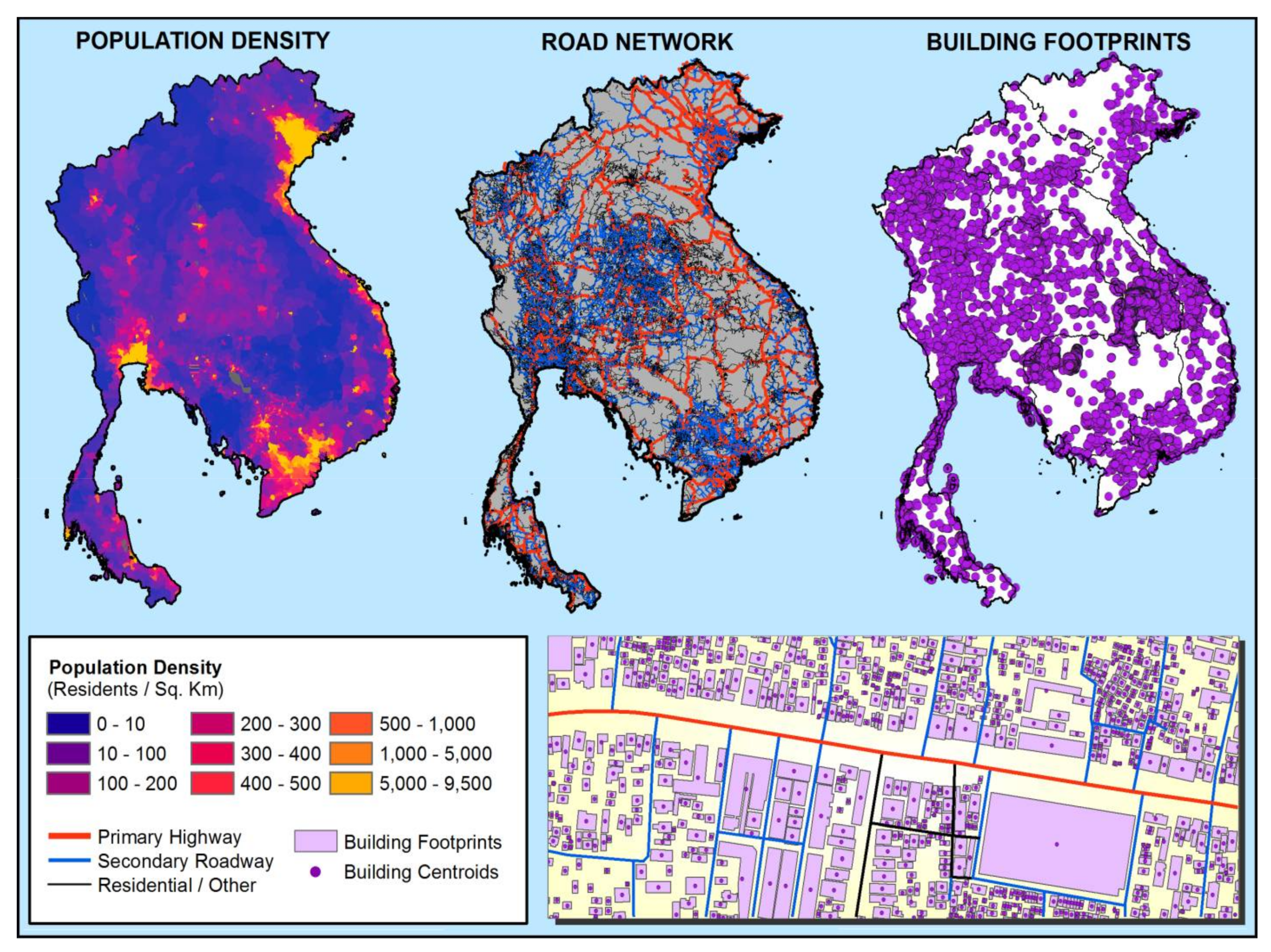
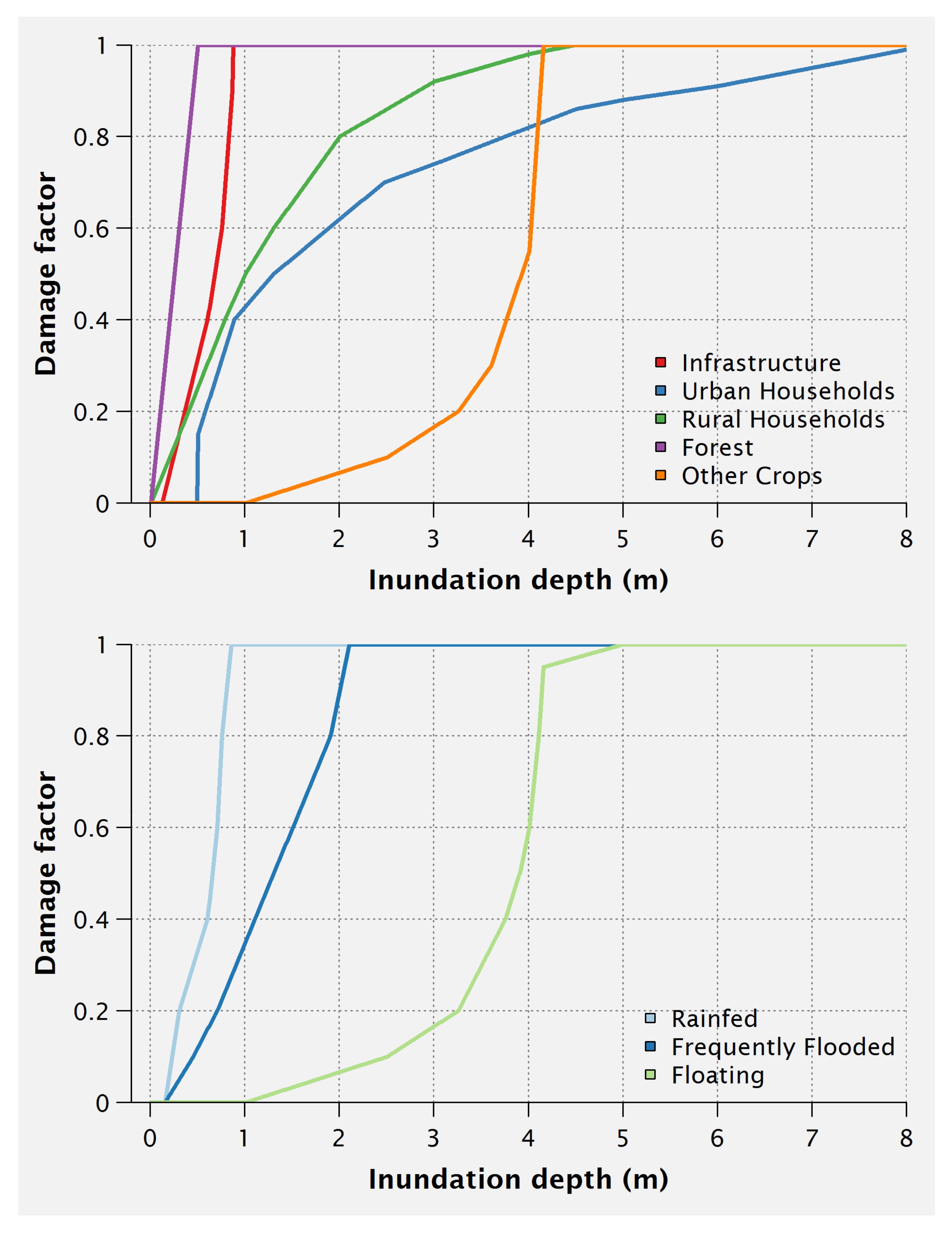

| Land Utility | USD/m2 | Source |
|---|---|---|
| Agriculture | ||
| Rice, totally destroyed | 0.078 | Leenders et al. (2009) |
| Crop, totally destroyed | 0.109 | |
| Other plants, totally destroyed | 0.147 | |
| Rice, partially destroyed | 0.027 | |
| Crop, partially destroyed | 0.030 | |
| Other plants, partially destroyed | 0.030 | |
| Fishery | ||
| Farm ponds and paddy fields | 0.639 | Leenders et al. (2009) |
| Shrimp and shell fish | 1.706 | |
| Freshwater fish | 0.048 | |
| Infrastructure | ||
| Urban area | 29 | Giang et al. (2009) |
| Rural area | 22 | |
| Provincial road | 80 | |
| National road | 400 | |
| Railway | 1000 | |
| Other crops | 0.02 | |
| Forest | 0.84 | |
| Land Utility | Area (km2) | Damages (USD) |
|---|---|---|
| Rice Rotated with Annual Crop | 13,355.05 | 645,235,056 |
| Annual Crop | 1502.03 | 126,696,853 |
| Shifting Cultivation | 38.02 | 3,073,550 |
| Orchard | 332.35 | 6,572,509 |
| Flooded Forest | 3542.54 | 2,889,181,644 |
| Grassland | 1938.22 | 44,535,518 |
| Shrub Land | 1398.63 | 34,103,750 |
| Urban | 275.17 | 710,538,630 |
| Bare Land | 68.65 | 0 |
| Industrial Plantation | 1.42 | 24,608 |
| Deciduous Forest | 8.43 | 2,905,977 |
| Evergreen Forest | 2.28 | 1,530,465 |
| Forest Plantation | - | - |
| Bamboo Forest | 11.35 | 8,798,317 |
| Coniferous Forest | - | - |
| Mangrove | 1.71 | 842,254 |
| Marsh/Swamp | 482.85 | 12,703,670 |
| Aquaculture | 8.32 | 211,169 |
| Aquaculture Rotated with Rice | 26.39 | 27,770 |
| Total | 22,993 | 4,486,981,740 |
© 2018 by the authors. Licensee MDPI, Basel, Switzerland. This article is an open access article distributed under the terms and conditions of the Creative Commons Attribution (CC BY) license (http://creativecommons.org/licenses/by/4.0/).
Share and Cite
Oddo, P.C.; Ahamed, A.; Bolten, J.D. Socioeconomic Impact Evaluation for Near Real-Time Flood Detection in the Lower Mekong River Basin. Hydrology 2018, 5, 23. https://doi.org/10.3390/hydrology5020023
Oddo PC, Ahamed A, Bolten JD. Socioeconomic Impact Evaluation for Near Real-Time Flood Detection in the Lower Mekong River Basin. Hydrology. 2018; 5(2):23. https://doi.org/10.3390/hydrology5020023
Chicago/Turabian StyleOddo, Perry C., Aakash Ahamed, and John D. Bolten. 2018. "Socioeconomic Impact Evaluation for Near Real-Time Flood Detection in the Lower Mekong River Basin" Hydrology 5, no. 2: 23. https://doi.org/10.3390/hydrology5020023





